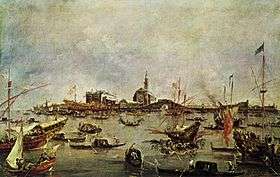San Nicolò al Lido
| Church of Saint Nicholas (San Nicolò al Lido) | |
|---|---|
|
San Nicolò al Lido | |
| Basic information | |
| Location | Venice, Italy |
| Geographic coordinates | 45°25′40″N 12°22′50″E / 45.427862°N 12.380603°ECoordinates: 45°25′40″N 12°22′50″E / 45.427862°N 12.380603°E |
| Affiliation | Roman Catholic |
| Province | Venice |
| Country | Italy |
| Status | Active |
| Architectural type | Church |
San Nicolò al Lido is a church in Venice, northern Italy. It is located in the northern part of Venice's Lido, and houses the relics of Saint Nicholas, patron of sailors (shared with Bari). From this church, the traditional thanksgiving mass of the Sposalizio del Mare ("Marriage of the Sea") is celebrated. The complex houses monks of the Franciscan order.

History
The convent and the church dates to the origins of Venice in the early Middle Ages.
The monastery and the church, according to a legend,[1] was founded by the Zancaruol family. The site stood at a strategic point for the nascent Venetian power: at the main access to the sea.
From here, in 996 and 998, sailed off the first Venetian expeditions against the Narentine pirates. On 9 May 1000, the fleet led by Doge Pietro Orseolo II took off for the campaign that led to the submission of Dalmatia. This event is still remembered in the Marriage of the Sea ceremony. In this church, Doge Domenico Selvo was elected and crowned in 1071, since St Mark's Basilica was under reconstruction. In 1099, the Venetian participation in the First Crusade departed from this port, led by the Bishop of Olivolo and Giovanni, son of the doge Vitale Michiel I.
In 1100, the relics of the body of St. Nicholas were putatively stolen from Myra of Lycia, and interred in this church. However, a few years earlier, in 1089, the remains of the saint had been entombed in Bari by Pope Urban II in person.
Nicholas was proclaimed protector of the Venetian fleet. In 1202, the forces of the Fourth Crusade left from here. In 1245 Salinguerra II of Torelli was buried here; he was a Ghibelline nobleman who held the city of Ferrara for many years, and who disputed the primacy of Este family. In 1623 the relics of St. Nicholas were transferred from the church to the monastery to accommodate the construction of the new building, before being placed back below the altar.

Architecture and art
The church, with a single nave, is annexed to a convent and a cloister, all dating to the 16th century. The Baroque campanile was erected in 1626-1629. The façade is surmounted by a statue of Doge Domenico Contarini, who patronized the convent. The interior houses works by Palma il Vecchio (Madonna with Child) and Palma il Giovane (San Giovannino). The three bells in G major date back to the 16th century.
The relics of Nicholas

The possession of the relics of St. Nicholas has long been disputed between Venice and Bari. In recent times some scientific inspections of the bones have been held, in Bari in 1953 (the first ever made) and in Venice (1992). Analyses found that the relics, divided between the two cities, belong to the same person: Bari has the larger bone fragments, while Venice has the smaller fragments, forgotten by Bari's sailor-men.
The presence of the relics in Venice is little known, so the church is not a place of pilgrimage like Bari, especially for Russian Orthodox.
Use in film and television
It was used as the Italian headquarters of MI6 in the 1979 James Bond film Moonraker.[2]
Notes
- ↑ Zancaruol - Historical Dictionary Of All The Notebook-Venetian Patrician Families
- ↑ http://www.imdb.com/title/tt0079574/locations
References
- Horatio Brown, chapter 'San Nicolo del Lido' in Life on the Lagoons (1884 and later editions)
.jpg)